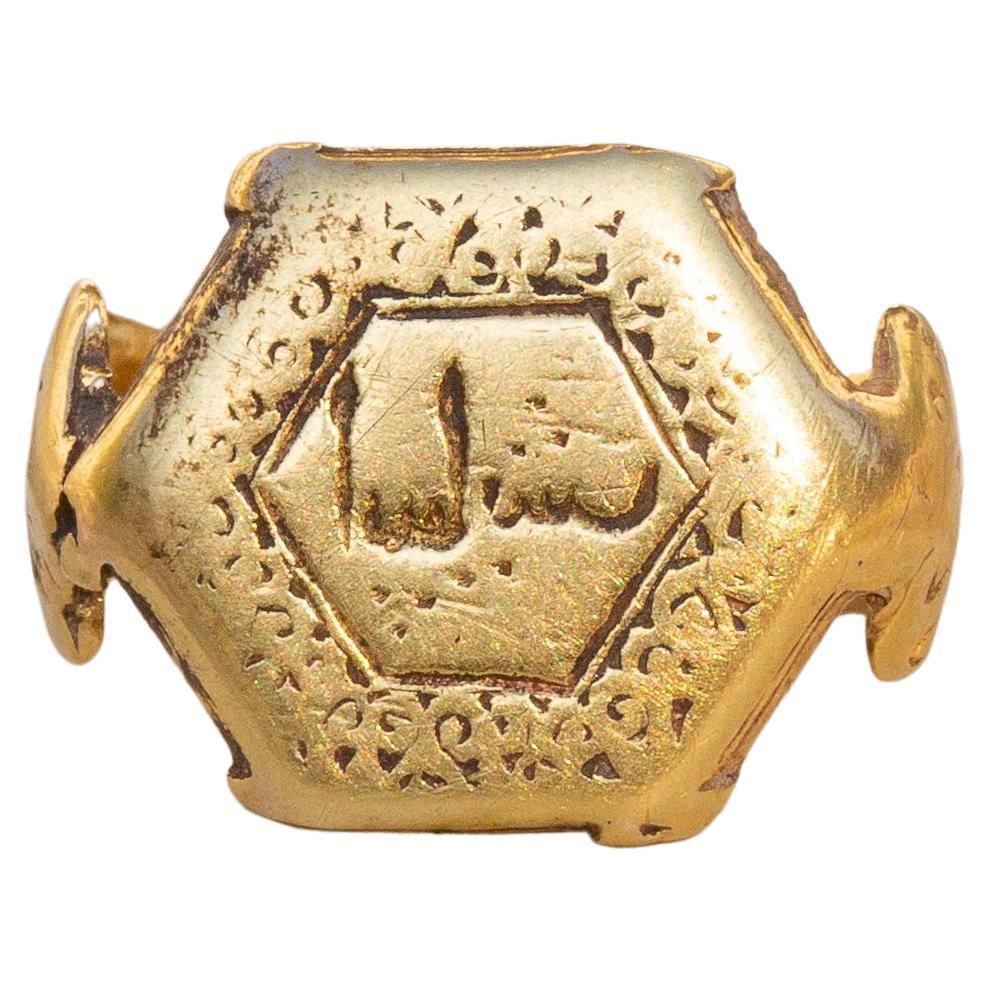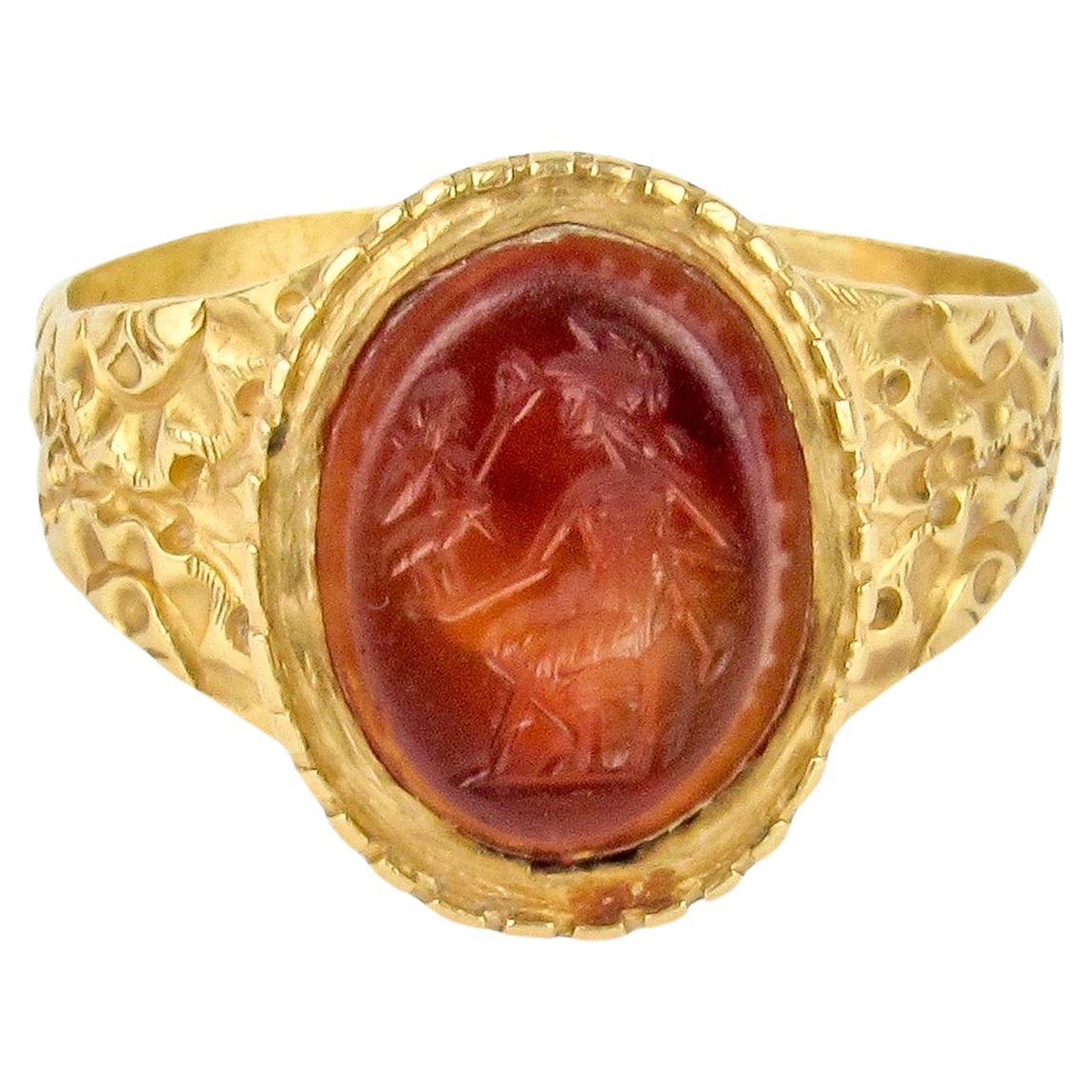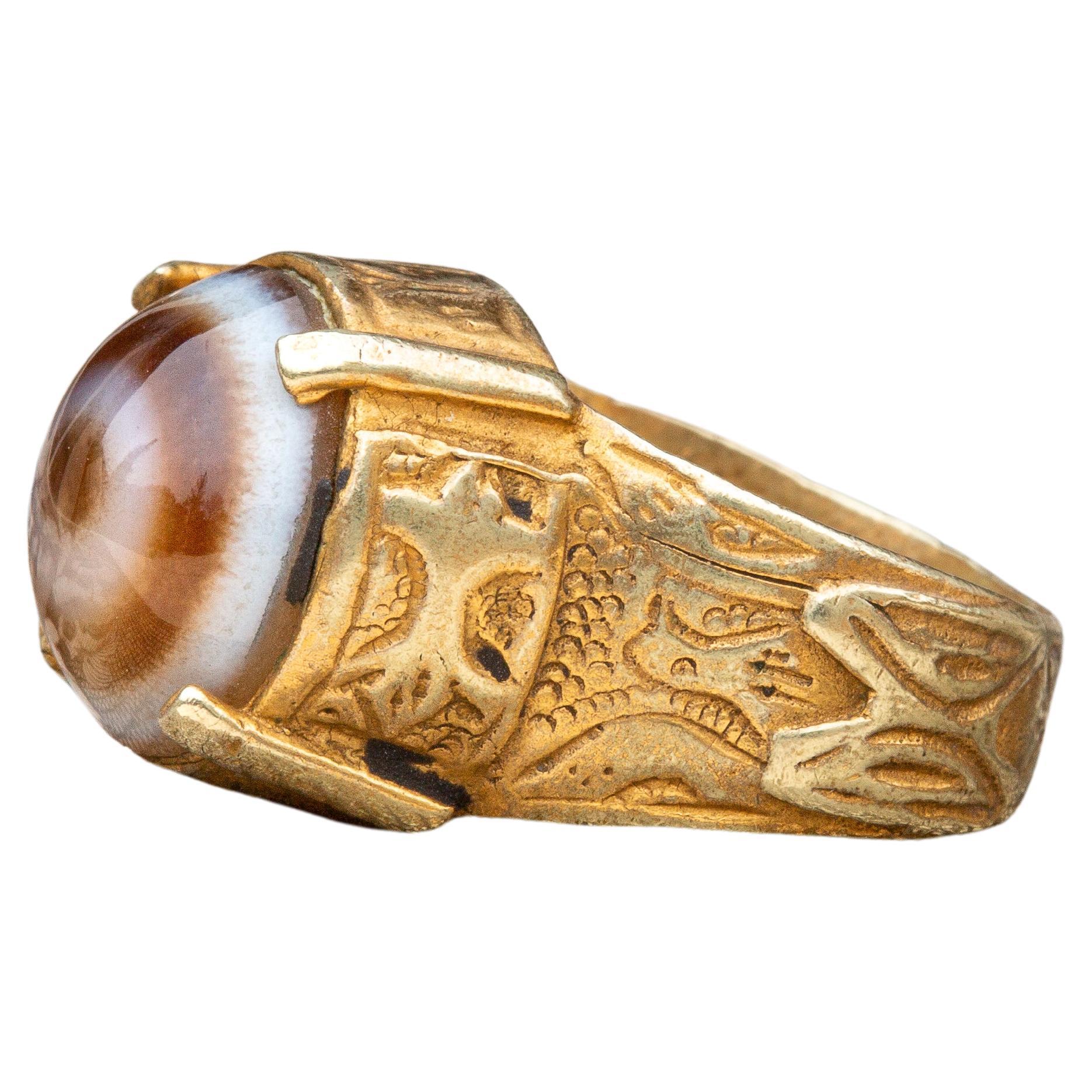Items Similar to Museum-Grade Antique Early Seljuk ‘Selçuklu’ Period Islamic Intaglio Ring
Want more images or videos?
Request additional images or videos from the seller
1 of 15
Museum-Grade Antique Early Seljuk ‘Selçuklu’ Period Islamic Intaglio Ring
About the Item
This incredible gold ring dates from the 12th century Seljuk dynasty. The carnelian intaglio is set within a typical Seljuk tapered rectangular bezel with a four-pronged gold setting soldered to the outside of the bezel. Applied and pierced arabesque designs are placed at the bottom of each prong which also reinforce the joints.
Further applied gold Seljuk ornamentation decorates the band, including two gold birds and a highly decorative vestigial sprued bottom (back-knob) from the casting. The gold mount itself is also ornately and intricately chased and nielloed with arabesque patterns. Remarkably, the niello work remains in exceptional condition, and can still be seen on the underside of the bezel which is decorated with a lattice pattern.
The carnelian intaglio seal is flat cut base with bevelled sides. This shape was predominantly used in the seals from the 8th to 11th century. The seal is engraved with angular Kufic script with forked terminals which dates the seal to the 9th-12th centuries (Porter, 2011).
For similar referenced examples in museums and notable collections, see final photos, in particular items 26 and item 27 in ‘Islamic Rings and Gems: the Benjamin Zucker Collection’ (1987).
UK size K, US size 5.25
The ring weighs 9.19 grams and is crafted in high-karat gold (21K gold).
The carnelian stone measures 11mm x 8mm x 3mm. The hollow box bezel measures 16mm x 10mm and protrudes 7mm from the base.
This museum-grade ring is a rare survivor, most existing examples have some damage to the ring, intaglio or niello - this is a scarce example in superb, original condition.
The Seljuks, a Turkish dynasty of Central Asian nomadic origins, became the new rulers of eastern Islamic lands following the defeat of the powerful Ghaznavids at the Battle of Dandanakan (1040). Under the Seljuk sultanate, which spanned from the 11th to the 13th century, goldsmiths and jewellers created works of unparalleled beauty and sophistication. Seljuk jewellery was known for its intricate patterns, delicate niello and filigree work, and use of precious gemstones. It was also prized for its symbolic significance, as jewellery was often used to convey messages of wealth, power, and status.
- Ring Size:5.25 US, Not Resizable
- Metal:
- Stone:
- Stone Cut:
- Weight:9.19 g
- Place of Origin:
- Period:
- Date of Manufacture:1150
- Condition:
- Seller Location:London, GB
- Reference Number:1stDibs: LU2845221994782
About the Seller
5.0
Vetted Seller
These experienced sellers undergo a comprehensive evaluation by our team of in-house experts.
Established in 2019
1stDibs seller since 2022
32 sales on 1stDibs
Typical response time: 11 hours
- ShippingRetrieving quote...Ships From: London, United Kingdom
- Return PolicyA return for this item may be initiated within 14 days of delivery.
More From This SellerView All
- Antique Seljuk ‘Selçuklu’ Period Gold Islamic Medieval Signet Ring 11th-13th CLocated in London, GBThis quite small (yet mighty) 21K gold ring dates to the 11-13th century Seljuk dynasty. The hexagonal bezel features a negative cursive inscription within a border containing arabes...Category
Antique 15th Century and Earlier Signet Rings
MaterialsGold
- Scarce 13th-14th Century Islamic Late Seljuk Empire Gold and Eye Agate RingLocated in London, GBA superb Islamic gold and agate ring dating from the 13th to 14th century. The brown ‘sheep’s eye’ agate cabochon sits within a truncated conical bezel with a four-pronged setting soldered to the outside, typical of Seljuk dynasty rings. In the space between the prongs, the bezel is engraved with various zoomorphic motifs. These engravings continue down the tapered, flat shank and each shoulder is decorated with a splayed bird. This animal based ornamentation was most commonly found on Seljuk rings towards the end of the empire (13th-14th century). For similar referenced examples of Seljuk rings see pages 55-69 in ‘Islamic Rings...Category
Antique 15th Century and Earlier Turkish Signet Rings
MaterialsAgate, Gold
- Important Antique Finnish 18K Coat of Arms Klinckowström Intaglio Signet RingLocated in London, GBA superb, scarce Finnish antique 18K gold ring that was made in Helsinki in the year 1854. The oval carnelian coat of arms intaglio is set in a large intricate gold repoussé work mount featuring scrolled foliate motifs. Incredibly, thanks to a full set of Finnish hallmarks, as well as from the intaglio carving itself, we can identify who commissioned and wore this superb seal ring. The coat of arms engraved into the carnelian gemstone is that of the Klinckowström family, an old Prussian noble house whose members played prominent roles in the history of Prussia, Sweden, Finland and Austria. The family was granted nobility in Sweden in 1684 by King Charles XI, and then received the rank of baron in 1759 from King Adolf Frederick. The baronial branch was listed in the Finnish House of Nobility (Ritarihuone) from 1818 until the family line ended in Finland in 1883. This baronial element can also be seen in the engraved coat of arms from the specific type of coronet used, it is set with pearls and known as a ‘Friherrlig rangkrona’, the coronet for Baron. The hallmarks tell us that this ring was made in Helsinki in the year 1854. Accordingly, the ring must have been made for a Baron (male) of the Klinckowström family, present and active in Finland during the mid-19th century. After researching into the genealogial records, only one member of the family settled in Finland, which was Baron Otto Wilhelm Klinkowström (1778-1850), and this ring would have been commissioned by his son Baron Arthur Wilhelm Wilhelmsson Klinckowström, shortly after his father’s passing. The ring would have been made in used to seal deeds and important letters in wax regarding family affairs. Arthur had two sons. Emil and Alexander who carried on the baronial title until 1883, when the family line ended on the male side. Although the time period of this ring also matches up with his both his sons, according to heraldry records they both carried a slightly different coat of arms. Arthur, the owner of this ring enrolled in the House of Knights in Finland aged 17 and soon after received the Order of St. John of Jerusalem. He spent the remainder of his years in various senior military positions, such as Lieutenant Colonel of the Finnish Sharpshooter Battalion and Colonel of the Kremenchugska Hunter Regiment. He passed away in 1860, not long after his father, which may explain why this ring is in such excellent condition with minimal signs of usage. His father, Baron Otto Wilhelm Klinkowström (1778-1850) was a Swedish lieutenant general who later moved to Finland, where he immediately found favour with Czar Alexander I of Russia...Category
Antique 1850s Finnish Victorian Signet Rings
Materials18k Gold
- Antique Gold Cameo Ring Greek Theatre Mask Silenus Hardstone Intaglio SignetLocated in London, GBA very unusual antique gold ring set with a carved brown and white hardstone cameo depicting the theatrical comic mask of Silenus, the Greek mythological old rustic god of wine-making and drunkenness. The ring was made in the late 19th century and carries French control marks for 18K gold, whilst the cameo is probably Italian and made slightly earlier, circa 1800. Silenus was a companion to the wine god Dionysus, and suitably he was a notorious consumer of wine, usually drunk and supported by satyrs or carried by a donkey. Silenus was described as the oldest, wisest and most drunken of the followers of Dionysus, and was said to possess special knowledge and the power of prophecy when intoxicated. He presides over the other satyrs and is related to musical creativity, prophetic ecstasy, drunken joy and drunken dances. Silenus was usually depicted as a jovial old man, bald yet bearded, with a pot-belly, thick lips and snub-nose. The masks worn to play him in theatre really emphasised these features, as you can see with this cameo carving Theatre was a key part of ancient Greek culture. The theatrical masks worn by the actors, known as ‘prosopon’, served various purposes. They enabled individual actors to play multiple roles (or genders) in the same performance; the exaggerated expressions helped define the character being portrayed; they helped spectators in the back rows to tell the characters apart. This particular masked as mentioned before is a comedic Silenus, please see final photo for other examples of Silenus masks in museum collections. UK size N 1/2, US size 7 4.84g 18K gold French ‘tête...Category
Antique Early 19th Century Italian Georgian Signet Rings
MaterialsAgate, 18k Gold
- Ancient Roman Green Chalcedony Plasma Intaglio Ring of Goddess Victoria NikeLocated in London, GBA scarce ancient Roman intaglio dating from the 1st to 2nd century AD, depicting Victoria, the Roman Goddess of Victory (also known as Nike in Greek mythology). The cabochon gemstone is a chromium chalcedony, mottled green in colour. It was known in the ancient world as a ‘plasma’ stone and was widely used in jewellery and seals throughout the Roman Empire. However the mineral disappeared from use in the ancient world towards the end of the 2nd century AD when the known deposits were mined out. The intricate ancient engraving depicts a winged Victoria, draped and facing left, holding a palm branch in her right hand and a laurel leaf in her left. The green gem is translucent and contains small dotted black natural inclusions. The gemstone’s viridian green tones were linked to nature, growth, and prosperity, reflecting the Romans' appreciation for abundance and fertility. Victoria played a major part of Roman society, with many temples erected in her honour including one on the Palatine Hill which would house the spoils of war from Roman victories. She was, to the Romans, a symbol of victory over death, ultimately determining who would be successful during war. The high number of artistic and architectural dedications to her bear witness to the popularity of the goddess’ cult: Victoria widely appears on Roman coins...Category
Antique 15th Century and Earlier Italian Classical Roman Signet Rings
MaterialsChalcedony, 22k Gold
- Antique 17th Century Engraved Silver Heraldic Coat of Arms Intaglio Signet RingLocated in London, GBThis rare heraldic silver intaglio signet ring dates from the late 17th century and originates from Western Europe. The flat, octagonal bezel is engraved with a noble family coat of arms depicting an eight pointed star. The silver ring is cast in one piece, the intaglio is framed within a chased octagonal border and the band displays flared and chamfered edges at the shoulders, all features typical of the period. After looking into heraldry archives, there are a few families in Western Europe which share this coat of arms, notably the Ambrogini family of Italy and the Counts of Waldeck, vassals of Luxembourg since the 14th century (see Ravensbury Antiques...Category
Antique Late 17th Century European Stuart Signet Rings
MaterialsSilver
You May Also Like
- Early 22k Carnelian Intaglio Ring of Jupiter Holding VictoryLocated in Hummelstown, PAEarly carnelian intaglio depicts Jupiter seated holding Victory Measurements: 16mm north to south, intaglio 12 x 9mm Weight: 5.6 grams Size: 8 3/4Category
Antique 1820s Signet Rings
MaterialsCarnelian, 22k Gold
- Antique Intaglio set in a 22K Yellow Gold Contemporary RingLocated in Aspen, CO22K yellow contemporary gold ring centering an antique carnelian intaglio, c. 1850, of a standing angel extending an olive branch - signifying peace. The intaglio is in fine conditio...Category
Late 20th Century American Contemporary Signet Rings
MaterialsCarnelian, 22k Gold, Yellow Gold
- Antique Carnelian Intaglio Ring, Louis VIIILocated in New York, NYAntique Carnelian Intaglio Ring from the mid to late 19th Century. Intricately and finely carved seal of a Louis VIII profile within a gold bez...Category
Antique 1870s French Victorian Signet Rings
MaterialsCarnelian, 14k Gold, Sterling Silver
- Antique Gold Roman Intaglio RingLocated in Chicago, ILRoman Ring with Intaglio of Mars Roman, 4th century AD, intaglio 3rd century AD Gold, nicolo Weight: 15.3 gr.; Circumference: 49.32 mm.; US size 5; UK size J ½ This deceptively heavy gold ring...Category
Antique 15th Century and Earlier Italian Classical Roman Band Rings
MaterialsOnyx, Gold
- Antique 18K TB Starr Medusa Intaglio RingLocated in Hummelstown, PAImmediately recognizable by her hair made of venomous snakes, Medusa is best known in Greek mythology for her petrifying gaze. Artfully fabricated by Theodore B. Starr, one of the mo...Category
Antique 1890s American Signet Rings
MaterialsCarnelian, 18k Gold
- Napoleonic Era Antique Intaglio Gold Signet RingLocated in Chicago, ILThis late 1790s - early 1800s carnelian intaglio features a neo-classical profile of Queen Luise of Prussia (1776-1810), who made neckerchiefs popular. Luise is wearing a neckerchief, a pearl tiara...Category
Antique Early 19th Century Neoclassical Signet Rings
MaterialsCarnelian, Gold





